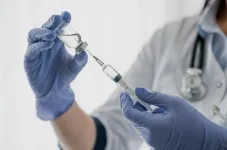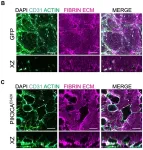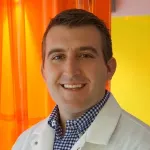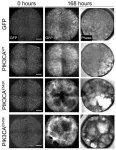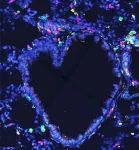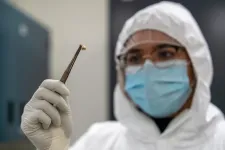(Press-News.org) LEXINGTON, Ky. (Feb. 24, 2023) — A recent University of Kentucky Markey Cancer Center study suggests a new radiopharmaceutical compound may be a viable treatment option for patients with advanced cervical cancer.
The study, led by UK Markey Cancer Center radiation oncologist Charles Kunos, M.D., and published in Frontiers in Oncology, validates that the radioactive drug 212Pb-DOTAM-GRPR1 may be useful in the treatment of persistent, recurrent, or metastatic cervical cancer.
Radiopharmaceuticals are expected to play an increasingly important role in the future of cancer treatment. They deliver radiation therapy directly to cancer cells, reducing the risk of damage to healthy tissue and resulting in improved treatment outcomes and reduced side effects compared to typical radiation therapy.
“As researchers develop new radiopharmaceutical agents, part of the clinical validation of these efforts is to provide proof that the targets are present in the cancer cells,” said Kunos, a professor of radiation medicine in the UK College of Medicine. “This study ensures that clinical trials using this agent have the best chance to be successful, which will ultimately bring these advanced therapies to the greater oncology market.”
Radiopharmaceuticals require a molecular target to deliver therapy to tumors. 212Pb-DOTAM-GRPR1 targets gastrin-releasing peptide receptor (GRPR), a protein expressed by cancer cells.
Kunos’ team evaluated tissue from 33 tumors from women who had metastatic cervical cancer. Most of the tissue studied overexpressed the GRPR, suggesting 212Pb-DOTAM-GRPR1 is a promising therapy to treat the disease.
“As Kentucky has the highest incidence and mortality rate of cervical cancer in the U.S., UK has a vested interest in finding new therapies for the disease," said Kunos. "Many of our patients are often presented with a much later stage disease and have the greatest need for a new targeted therapy like a radiopharmaceutical.”
The results also validate a phase 1 clinical trial of 212Pb-DOTAM-GRPR1 that is already underway at Markey.
The study is also helping to make the next generation of cancer treatment available to Kentuckians who need it most. Markey is currently only one of only two specialized cancer centers in the U.S. to offer this agent in a clinical trial, and one of a few centers that can offer radiopharmaceuticals.
Research reported in this publication was supported by the National Cancer Institute of the National Institutes of Health under Award Number P30CA177558. The content is solely the responsibility of the authors and does not necessarily represent the official views of the National Institutes of Health.
UK HealthCare is the hospitals and clinics of the University of Kentucky. But it is so much more. It is more than 10,000 dedicated health care professionals committed to providing advanced subspecialty care for the most critically injured and ill patients from the Commonwealth and beyond. It also is the home of the state’s only National Cancer Institute (NCI)-designated cancer center, a Level IV Neonatal Intensive Care Unit that cares for the tiniest and sickest newborns, the region’s only Level 1 trauma center and Kentucky’s top hospital ranked by U.S. News & World Report.
As an academic research institution, we are continuously pursuing the next generation of cures, treatments, protocols and policies. Our discoveries have the potential to change what’s medically possible within our lifetimes. Our educators and thought leaders are transforming the health care landscape as our six health professions colleges teach the next generation of doctors, nurses, pharmacists and other health care professionals, spreading the highest standards of care. UK HealthCare is the power of advanced medicine committed to creating a healthier Kentucky, now and for generations to come.
END
Markey Cancer Center study shows potential for new radiopharmaceutical cancer treatment
2023-02-24
ELSE PRESS RELEASES FROM THIS DATE:
A mysterious object is being dragged into the supermassive black hole at the Milky Way’s center
2023-02-24
For two decades, scientists have observed an elongated object named X7 near the supermassive black hole at the center of the Milky Way and wondered what it was. Was it pulled off a larger structure nearby? Was its unusual form the result of stellar winds or was it shaped by jets of particles from the black hole?
Now, having examined the evolution of X7 using 20 years of data gathered by the Galactic Center Orbit Inintiative, astronomers from the UCLA Galactic Center Group and the Keck Observatory propose that it could be a cloud of dust and gas that was ejected during the collision of two stars.
Over time, they report, X7 has stretched, and it is being pulled apart ...
How a new blood-vessel-on-a-chip can help researchers further understand vascular malformations
2023-02-24
CHAPEL HILL, N.C. – Our bodies are made up of 60,000 miles of complex pipes that play a vital role in transporting nutrients throughout our bodies, performing waste disposal, and supplying our organs with fresh oxygen and blood.
Vascular malformations (VMs) are a group of rare genetic disorders that causes an abnormal formation of veins, arteries, capillaries, or lymphatic vessels at birth. VMs can interfere with the duties of our precious pipes by causing blockages, poor drainage, and the formation of cysts and tangles.
To address a need for further study, William Polacheck, PhD, an assistant professor at the ...
CHOP researchers identify molecules that optimize immune presentation of antigens across the human population
2023-02-24
Philadelphia, February 24, 2023—Researchers at Children’s Hospital of Philadelphia (CHOP) have identified variants of a chaperone molecule that optimizes the binding and presentation of foreign antigens across the human population, which could open the door to numerous applications where robust presentation to the immune system is important, including cell therapy and immunization. The findings were published today in Science Advances.
Class I major histocompatibility complex (MHC-I) proteins are ...
Researchers find several oceanic bottom circulation collapses in the past 4.7 million years
2023-02-24
Antarctic bottom water (AABW) covers more than two-thirds of the global ocean bottom, and its formation has recently decreased. However, its long-term variability has not been well understood.
Researchers led by Prof. DENG Chenglong from the Institute of Geology and Geophysics (IGG) of the Chinese Academy of Sciences (CAS) and their collaborators have reconstructed AABW history back to approximately 4.7 million years ago (mya). They found that AABW has collapsed several times and such collapses might have induced moisture transport to fuel the Northern Hemisphere ...
Protection against allergic asthma: When innate lymphoid cells educate alveolar macrophages
2023-02-24
A study conducted by researchers at the University of Liège on group 2 innate lymphoid cells (or ILC2s) shows that the functional reprogramming of these cells following their exposure to viruses allows our body to react differently to exposure to certain respiratory allergens. This study is published in Science Immunology.
The hygiene hypothesis states that exposure during childhood to certain micro-organisms protects against the development of allergic diseases such as asthma. In this context, researchers from the immunology-vaccinology laboratory (FARAH research ...
Researchers investigate pre-clinical model for clinically relevant treatments for heart attacks
2023-02-24
CÚRAM SFI Research Centre for Medical Devices researchers have published in Nature Communications a key study establishing a new pre-clinical model to develop clinically relevant treatments for heart attacks.
Heart attacks (myocardial infarction (MI)) occur due to an acute complication of coronary artery disease and are a major cause of global mortality. The two main types of heart attack are ST-elevation (STEMI) and Non-ST elevation (NSTEMI). A non-ST-elevation is a type of heart attack that usually happens when your heart's oxygen needs are unmet. This condition gets its name because it doesn't have an easily identifiable electrical pattern like with an ...
Palliative care doesn’t improve psychological distress
2023-02-24
Palliative care — a specialized medical care focused on quality of life for people with a serious illness such as cancer or heart failure — isn’t likely to reduce psychological distress, according to a Rutgers study.
Researchers involved with the study, published in the Journal of Pain and Symptom Management, found there were no statistically significant improvements in patient or caregiver anxiety, depression or psychological distress in a meta-analysis of 38 randomized clinical trials of palliative care interventions. This study took results ...
Research brief: Verapamil shows beneficial effect on the pancreas in children with newly-diagnosed type 1 diabetes
2023-02-24
MINNEAPOLIS/ST. PAUL (02/24/2023) — Published in JAMA, a University of Minnesota led study shows that verapamil, a drug commonly used to treat high blood pressure and heart conditions, can have a beneficial effect on the pancreas in children with newly-diagnosed type 1 diabetes (T1D).
Results of the CLVer clinical trial showed that oral verapamil taken once a day improved the pancreas' insulin secretion by 30% over the first year following diagnosis of T1D when compared with a control group that received a placebo.
“The beneficial effect of verapamil observed in the trial is extremely exciting,” said Antoinette Moran, MD, the ...
A simpler way to track the spread of infectious diseases
2023-02-24
How society organizes affects different phenomena, from the transmission of information to the spread of contagious diseases. The more links we establish with each other via social and transportation networks, the more spread is favored. To study the dynamics of complex systems, such as society, we can infer these networks – in which nodes, representing individuals, connect through lines – from real-world data. However, these networks are usually large, dense, and cumbersome to manipulate.
In previous work, Luís M. Rocha’s group at the Instituto Gulbenkian de Ciência (IGC) found a way to simplify networks ...
Deadly waves: Researchers document evolution of plague over hundreds of years in medieval Denmark
2023-02-24
Attention editors: Under embargo by the journal Current Biology until Friday, February 24 at 11 a.m. eastern
Scientists who study the origins and evolution of the plague have examined hundreds of ancient human teeth from Denmark, seeking to address longstanding questions about its arrival, persistence and spread within Scandinavia.
In the first longitudinal study of its kind, focusing on a single region for 800 years (between 1000-1800AD), researchers reconstructed Yersinia pestis genomes, the bacterium responsible for the plague, and showed that it was reintroduced into the Danish population from other parts of Europe again and again, perhaps via ...
